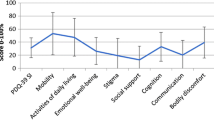Abstract
The search for valid instruments to measure different domains of health disturbances becomes increasingly important for the assessment of Parkinson’s disease. The most widely used tool is the Unified Parkinson’s Disease Rating Scale (UPDRS) which was introduced in 1987 and is currently awaiting revision. In addition, a variety of instruments have been used to capture non-motor aspects of Parkinson’s disease but only a minority of these instruments has been validated for this particular disease condition. Measurements of quality of life are being incorporated into an increasing number of studies in order to reflect a more integral view of health and have contributed to a better understanding of the impact of disease and interventions. The International Classification of Functioning, Disability and Health introduced by the WHO in 2001 offers a multidimensional approach to human functioning and participation that can also be applied to the assessment of health status in PD. This workshop report will focus on the present state of clinimetry in PD and discuss future perspectives.
Similar content being viewed by others
References
Chaudhuri KR, Martinez-Matín P, Schapira AHV et al. (2006) International multicenter pilot study of the first comprehensive self-completed nonmotor symptoms questionnaire for Parkinson’s disease: The NMSQuest study. Mov Disord 21:916–923
Fahn S, Elton RL (1987) UPDRS program members Parkinson’s Disease Rating Scale. In: Fahn S, Marsden CD, Goldstein M, Calne DB (eds) Recent developments in Parkinson’s disease, vol. 2, Macmillanm Healthcare Information, Florham Park, pp 153–163
Friedberg G, Zoldan J, Weizman A, Melamed E (1998) Parkinson Psychosis Rating Scale: a practical instrument for grading psychosis in Parkinson’s disease. Clin Neuropharmacol 21:280–284
Goetz CG, Stebbins GT, Chmura Ta, et al. (1995) Teaching tape for the motor section of the Unified Parkinson’s Disease Rating Scale. Mov Disord 10:263–266
Koller W, Guarnieri M, Hubble J, Rabinowicz AL, Silver D (2005) An open-label evaluation of the tolerability and safety of Stalevo (carbidopa, levodopa and entacapone) in Parkinson’s disease patients experiencing wearing-off. J Neural Transm 112(2):221–230
Korczyn AD, Brunt ER, Larsen JP, et al. (1999) A 3-year randomized trial of ropinirole and bromocriptine in early Parkinson’s disease: the 053 Study Group. Neurology 53:364–370
Marras C, Lang A, Krahn M, et al. (2004) Quality of life in early Parkinson’s disease: impact of dyskinesias and motor fluctuations. Mov Disord 19:22–28
Mitchell SL, Harper DW, Bhalla R (2000) Patterns of outcome measurements in Parkinson’s disease clinical trials. Neuroepidemiology 19:100–108
Miyasaki JM, Shannon K, Voon V, et al. (2006) Practice Parameter: Evaluation and treatment of depression, psychosis, and dementia in Parkinson disease (an evidence-based review). Report of the Quality Standards Subcommittee of the American Academy of Neurology. Neurology 66:996–1002
Movement Disorder Society Task Force on Rating Scales for Parkinson’s Disease (2003) The Unified Parkinson’s Disease Rating Scale (UPDRS): Status and recommendations. Mov Disord 18:738–750
Peto V, Jenkinson C (1999) Quality of life measures in Parkinson’s disease. In: Martín PM, Koller WC (eds) Quality of life in Parkinson’s disease. Masson S. A., Barcelona, pp 37–54
Poewe WH, Deuschl G, Gordin A, Kultalahti ER, Leinonen M (2002) Efficacy and safety of entacapone in Parkinson’s disease patients with suboptimal levodopa response: a 6-month randomized placebo-controlled doubleblind study in Germany and Austria (Celomen study). Acta Neurol Scand 105(4):245–255
Ramaker C, Marinus J, Stiggelbout, et al. (2002) Systematic evaluation of rating scales for impairment and disability in Parkinson’s disease. Mov Disord 17:867–876
Rascol O, Brooks DJ, Brunt ER, et al. (1998) Ropinirole in the treatment of early Parkinson’s disease: a 6-month interim report of a 5-year levodopa-controlled study—056 Study Group. Mov Disord 13:39–45
Reichmann H, Boas J, Macmahon D, Myllyla V, Hakala A, Reinikainen K (2005) Efficacy of combining levodopa with entacapone on quality of life and activities of daily living in patients experiencing wearing-off type fluctuations. Acta Neurol Scand 111(1):21–28
Richards M, Marder K, Cote L, et al. (1994) Interrater reliability of the Unified Parkinson’s Disease Rating Scale motor examination. Mov Disord 9:89–91
Schrag A, Jahanshahi M, Quinn N (2000) What contributes to quality of life in patients with Parkinson’s disease? J Neurol Neurosurg Psychiatry 69(3):308–312
Schrag A, Jahanshahi M, Quinn N (2000) How does Parkinson’s disease affect quality of life? A comparison with quality of life in the general population. Mov Disord 15(6):1112–1118
Schrag A, Sampaio C, Counsell N, Poewe W (2006) Minimal clinically important change of the Unified Parkinson’s Disease Rating Scale. Mov Disord, (in press) DOI 10.1002/mds.20914
World Health Organization (2002) Towards a Common Language for Function Disability and Health. Geneva. www.who.int/icf
Author information
Authors and Affiliations
Corresponding author
Rights and permissions
About this article
Cite this article
Ebersbach, G., Baas, H., Csoti, I. et al. Scales in Parkinson’s disease. J Neurol 253 (Suppl 4), iv32–iv35 (2006). https://doi.org/10.1007/s00415-006-4008-0
Issue Date:
DOI: https://doi.org/10.1007/s00415-006-4008-0



